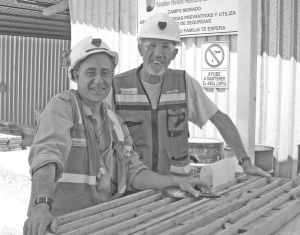VANCOUVER — The sun is shining on Farallon Resources (FAN-T, FRLLF-O). The company is just a few months shy of production at Campo Morado, in Mexico, and now drills have hit a new high-grade zone close to the main production decline, while also returning the highest grades to date at the polymetallic property.
Farallon has two drill rigs working to expand the resources around the main G-9 deposit. While the first few expansion holes to the northwest did not hit mineralization, a second try revealed a new highgrade sulphide lens that Farallon has dubbed the West extension.
Two drill holes hit the new zone. Hole 725 cut two mineralized intervals: 9.68% zinc, 1.37% lead, 1.26% copper, 83 grams silver per tonne and 0.74 gram gold over 6 metres from 436 metres down-hole, followed 20 metres deeper by 22.8 metres grading 12.7% zinc, 1.31% lead, 1.48% copper, 97 grams silver and 1.4 grams gold. Nearby, hole 729 returned 38.5 metres of 10.76% zinc, 0.82% lead, 1.19% copper, 114 grams silver and 1.59 grams gold from 457 metres down-hole. All intervals are true widths.
The West extension is significant not only because of its high grades but because the underground declines currently under development will pass directly through the zone, adding a new area of high-grade starter material for the underground operation. At press time, the main production decline was expected to have hit the new zone within days.
Prior to discovering the West extension, production at Campo Morado was to start from the North zone, which is adjacent to the new zone at the south end but angles away to lie 150 metres distant at the north end. The North zone already hosts 691,000 indicated tonnes grading 3.37 grams gold, 188.8 grams silver, 1.31% lead, 1.23% copper and 8.4% zinc, as well as 786,000 inferred tonnes grading 3.12 grams gold, 183.3 grams silver, 1.32% lead, 1.04% copper and 8.8% zinc.
However, the North zone is made up of multiple, unevenly stacked lenses that are easy to miss in drilling and thus continued infill drilling to better define the zone is important. Recent high-grade results indicate the extra effort is paying off.
Hole 709 cut 12 metres grading 22.72% zinc, 1.41% lead, 2.39% copper, 334 grams silver per tonne and 3.75 grams gold from 498 metres down-hole. Hole 713, collared some 20 metres away but directed to the southeast rather than the west, returned 13.7 metres grading 13.26% zinc, 0.35% lead, 1.61% copper, 148 grams silver and 3.32 grams gold from 503 metres depth. And hole 719, collared 100 metres southwest but pointed northeast, cored 34.6 metres grading 11.54% zinc, 0.36% lead, 1.55% copper, 168 grams silver and 3.83 grams gold.
Farallon wants to expand G-9 but has an equally important, longer-term goal: to find another G-9. To that end, the company is using its third drill rig to step out from the Abajo zone, the only G-9 zone north of the northwest-trending San Raphael fault. Until hitting mineralization at Abajo, Farallon thought the fault marked the northeast limit of mineralization. But a few hits at Abajo in 2007 opened up the entire area north of the fault to further exploration.
Results from the first two stepout holes in the 2008 drill program yielded a hit and a miss. Hole 718 intersected a short, high-grade interval: 8.75 metres grading 16.3% zinc, 0.75% lead, 1.71% copper, 167 grams silver and 1.99 grams gold from 407 metres down-hole. Hole 720 failed to hit significant mineralization.
The next four holes produced two more significant hits that extended the zone to the north. Hole 727 cut 13 metres grading 10.01% zinc, 4.97% lead, 1.57% copper, 213 grams silver and 4.23 grams gold, and hole 728 returned 9.3 metres grading 15.9% zinc, 1.48% lead, 1.77% copper, 279 grams silver and 2.88 grams gold. The other two holes, which stepped even farther north, did not hit mineralization.
The news, which came in two sets, boosted trading activity but left Farallon’s share price unchanged at 74. The company has a 52-week trading range of 54-92 and has 336 million shares issued.
Farallon started work at Campo Morado in 1995. The 116-sq.-km property in Guerrero state is home to several volcanogenic massive sulphide (VMS) deposits. Four of those deposits — Reforma, Naranjo, El Rey, and El Largo — sit within the same stratigraphic horizon and are fine-grained and therefore difficult to process. A fifth, discovered in 2005 under the property’s ninth gravity anomaly and therefore called G-9, is on a lower horizon and is coarse-grained.
An intense exploration focus at G-9 over two years outlined a measured and indicated resource of 2.18 million tonnes grading 3 grams gold, 209.1 grams silver, 1.32% lead, 1.48% copper and 11% zinc within four zones. Two of those zones — the North and Southeast zones — are considerably higher-grade and will be the focus in the first few years of mining.
The deposit sits inside a steep hill, some 600 metres from surface. But the steep ravine running along the hill’s west side provides an entry point for the underground operation. Two declines, 15 metres apart, are being advanced from the base of the ravine into the hill, descending at an 8 angle.
The key to Farallon’s rapid move from discovery to production is parallel-track mine development: Farallon started purchasing major pieces of mill equipment before even starting a prefeasibility study and was halfway through mine development before a preliminary assessment was complete. The company does not plan to complete a feasibility study.
Ore will be processed via conventional flotation to produce three concentrates: zinc, copper and lead.
While the silver and gold grades in the ore are impressive, unfortunately the precious metal mineralization is refractory and thus recoveries are low, though each concentrate will have silver and gold credits.


Be the first to comment on "Farallon hits new highgrade near decline"